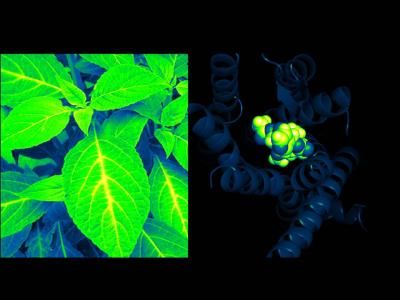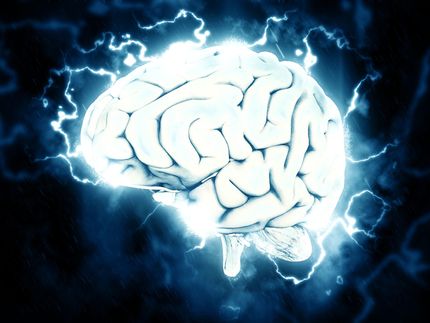Structure of 'Salvia' receptor solved
At the molecular level, drugs like salvinorin A (the active ingredient of the hallucinogenic plant Salvia divinorum) work by activating specific proteins, known as receptors, in the brain and body.

On the left panel is a Salvia divinorum plant. On the right panel, location of drug salvinorin A in the kappa opioid receptor.
Roth lab, UNC-Chapel Hill.
Salvinorin A, the most potent naturally occurring hallucinogen, is unusual in that it interacts with only one receptor in the human brain — the kappa opioid receptor (KOR). Scientists know of four distinct types of opioid receptors, but until now the structure of the 'salvia receptor', and the details about how salvinorin A and other drugs interact with it, was a mystery.
In a research paper published in Nature, scientists from the University of North Carolina at Chapel Hill, Scripps Research Foundation and two other institutions revealed the first-ever glimpse of the complete structure of the KOR. The finding could accelerate the development of new drugs to treat addiction, depression, anxiety, chronic pain and many other conditions.
"Once we see the structure of the receptor, it becomes easier for us to develop drugs that target the receptor in ways that might be beneficial for medical therapy," said Bryan Roth, MD, PhD, the Michael Hooker Distinguished Professor of Pharmacology at UNC and one of the paper's authors. "Drugs that block the receptor are potentially useful for treating a number of serious illnesses including chronic pain, cocaine addiction and other diseases."
The KOR is responsible for the action of drugs that affect human consciousness, awareness of pain and mood. The KOR is the only receptor that binds salvinorin A - the active ingredient of the widely-abused hallucinogenic plant Salvia divinorum (also known as 'Magic mint', 'Salvia' and so on).
Knowing KOR's structure offers insights about how salvia and other drugs work. The finding also could help scientists design medicines that either activate or block KOR to benefit patients.
The research team crystallized KOR using JDTic, a drug currently in early-stage human trials; JDTic keeps KOR in an inactive state and blocks the actions of salvinorin A. In studies using animal models, JDTic has shown promise for treating cocaine and nicotine addiction, depression and anxiety.
The downside of JDTic and similar drugs targeting KOR is that they can exert their actions for weeks, whereas most prescribed medicines are cleared within 18-24 hours. "Now that we have the [KOR] structure, it opens up the possibility for us to make drugs that have the same action as JDTic but have better pharmaceutical properties," said Roth.
The research also resolves longstanding scientific debates about how drugs bind to KOR. The study found that compared to other receptors, the binding site on KOR is enormous, allowing drugs to bind to it in more than one way.
In addition, Roth said the research could help scientists develop drugs that activate KOR in the body without affecting the brain, which could be useful for treating chronic pain, kidney problems and many other disorders.
Most read news
Other news from the department science

Get the life science industry in your inbox
By submitting this form you agree that LUMITOS AG will send you the newsletter(s) selected above by email. Your data will not be passed on to third parties. Your data will be stored and processed in accordance with our data protection regulations. LUMITOS may contact you by email for the purpose of advertising or market and opinion surveys. You can revoke your consent at any time without giving reasons to LUMITOS AG, Ernst-Augustin-Str. 2, 12489 Berlin, Germany or by e-mail at revoke@lumitos.com with effect for the future. In addition, each email contains a link to unsubscribe from the corresponding newsletter.


















































